 “Naishkarma means not undertaking activities that will produce good or bad effects. Negation does not mean negation of the positive. Negation of the nonessentials does not mean negation of the essential. Similarly, detachment from material forms does not mean nullifying the positive form. The bhakti cult is meant for realization of the positive form.” (Shrila Prabhupada
“Naishkarma means not undertaking activities that will produce good or bad effects. Negation does not mean negation of the positive. Negation of the nonessentials does not mean negation of the essential. Similarly, detachment from material forms does not mean nullifying the positive form. The bhakti cult is meant for realization of the positive form.” (Shrila Prabhupada
An aspect of Vedic teachings unique to its discipline is the information presented about the soul, its position with respect to matter, and the need for avoiding harmful behavior, i.e. sin. The concept of sin surely isn’t exclusive to any single spiritual tradition, but the most complete explanation provided for its existence and the cause of its harmful effects is found only in the Vedic tradition, the oldest system of spirituality in the world. Despite the importance of sin the highest perfection of life does not come from only avoiding the bad. If it did, the roadmap in life would be pretty straightforward. Just steer clear of harmful influences and live happily. The key ingredient for spiritual merits, in finding bliss that transcends both good and bad, is to accept behavior that is all positive, having only a beneficial influence on the future. That acceptance comes through bhakti-yoga, or devotional service
 Are good and bad pretty much the same? This is the secret known to those who humbly submit before aspiritual master
Are good and bad pretty much the same? This is the secret known to those who humbly submit before aspiritual master
Bearing this in mind, the existence of an original person, He who passes down supreme wisdom aimed at furthering a better position, must be accepted on faith in the beginning. Lest we think this is a dangerous road to travel, the practice of extending faith is already widely prevalent in society. Every single person puts tremendous faith in others, even those who are known to be unworthy of it. The politician is the classic example. Although they promise this and that, the constituents inherently know that their political leaders lie to get ahead, that they follow whatever line of argument suits them for a particular day. This is why the popularly elected governments are filled with lawyers. A good lawyer can argue any position, using the written words of existing law codes to support their argument. In this sense when a politician who is a lawyer by trade is called out for their duplicity, for their hypocrisy in statements, they are essentially being complimented, for their ability to change positions with conviction shows that they are good at practicing law.
Faith is extended to others because of the results that come from believing in them. We trust that what our teachers are instructing is valid. We don’t know any better; otherwise we would have no reason to sit in the classroom. We accept the statements made by the television news anchors and we believe that the video footage they show is not fabricated. Following a similar tact, when faith is extended to the words of the spiritual master belonging to a line of instruction connected to the original person, there are inherent benefits that must come about. The arrival of these benefits validates the authenticity of both the instructor and his original teacher.
This is where some issues arise. If a spiritual leader tells us that we’re going to hell if we don’t openly declare allegiance to a particular personality, the validity of their statement will not be known until the afterlife. If the existence of the afterlife is already in question, why would the fear of punishment in it be taken seriously? Thus we see one of the major causes for the rampant lack of religiosity pervading the land today. “Follow me or you’re going to hell”, doesn’t work as a selling point because there is no tangible information provided about the person being surrendered to or what the hellish condition is. Moreover, why would punishment be coming to those who are kind, honest, decent and generally pious?
 The Vedas, through their mouthpieces of the scriptures and the words of those who follow the lessons from the texts of these works, reveal a lot more information about heaven, hell, sin, piety, and the ultimate purpose in life. The first instruction taught to aspiring transcendentalists is aham brahmasmi, which means “I am Brahman.” Is Brahman a person? Is Brahman a thing, some type of exalted post? Brahman is spirit. Why is it important to know this? Knowing that I am Brahman means that I have properly identified myself. In any other identification, there is a flaw, or at least a limitation. If a limit is introduced, there will come a point when enjoyment is checked. When enjoyment is checked we get an unpalatable situation, which means that we encounter our own mini version of hell.
The Vedas, through their mouthpieces of the scriptures and the words of those who follow the lessons from the texts of these works, reveal a lot more information about heaven, hell, sin, piety, and the ultimate purpose in life. The first instruction taught to aspiring transcendentalists is aham brahmasmi, which means “I am Brahman.” Is Brahman a person? Is Brahman a thing, some type of exalted post? Brahman is spirit. Why is it important to know this? Knowing that I am Brahman means that I have properly identified myself. In any other identification, there is a flaw, or at least a limitation. If a limit is introduced, there will come a point when enjoyment is checked. When enjoyment is checked we get an unpalatable situation, which means that we encounter our own mini version of hell.
How does this work exactly? Let’s suppose that I identify myself as a human being instead of Brahman. This seems like a broad enough generalization, something which transcends the sectarian boundaries formed off of religious tradition, skin color, nationality, etc. Essentially all of the ills caused by factional strife are rooted in false identification. If I know that I am a human being, these issues will go away, at least for me. The problem is that if I only identify as a human being, I might have the tendency to disrespect other forms of life. I may not have a problem killing an innocent cow
Thus far the flawed identification would result only in harm to other creatures, as needlessly killing a cow or other non-human life form seems like it wouldn’t carry any personal negative consequences. Man has dominion over the plants and lower animals. God made man superior for a reason, no? Karma becomes especially relevant in this area. Every action has a reaction, even if that reaction is not known. This fact is especially evident in the behavior of children. A young child has no idea that if they place their hand into a fire, they will get burned. Ignorance in this respect has no bearing on the consequence of the action. The fire will burn because that is what it is meant to do.
Similarly, just because the human being doesn’t know about karma doesn’t mean that they will be saved from the negative consequences to action. If we kill innocent creatures, we are bound to suffer the same fate in the future. This is only fair after all. There can be endless debates over what is fair and what is not, but in the end everything works out. Karma is the ultimate system of fairness. We just think that life is unfair because we don’t always see karma’s results or we forget about past transgressions. Sometimes the effects are short-lived and sometimes they manifest in the future, when the soul accepts another body.
“The humble sage, by virtue of true knowledge, sees with equal vision a learned and gentle brahmana, a cow, an elephant, a dog and a dog-eater [outcaste] .” (Lord Krishna, Bhagavad-gita, 5.18)
 The soul can accept new bodies? Here we start to uncover the importance in identifying oneself as Brahman. A unique aspect of Vedic teachings is that information about Brahman is presented. Not only are all human beings equal constitutionally, so are all living entities. A learned sage sees no difference between a gentle brahmana [priest], a cow, a dog, and a dog eater. It seems a little strange when you first hear of this, but there can be no doubt as to its validity. After all, not all human beings are the same. Some are tall, while others are short. Some are intelligent, while others are lacking mental acuity. This doesn’t mean that there is any inherent difference, for we all start from the same point in infancy.
The soul can accept new bodies? Here we start to uncover the importance in identifying oneself as Brahman. A unique aspect of Vedic teachings is that information about Brahman is presented. Not only are all human beings equal constitutionally, so are all living entities. A learned sage sees no difference between a gentle brahmana [priest], a cow, a dog, and a dog eater. It seems a little strange when you first hear of this, but there can be no doubt as to its validity. After all, not all human beings are the same. Some are tall, while others are short. Some are intelligent, while others are lacking mental acuity. This doesn’t mean that there is any inherent difference, for we all start from the same point in infancy.
The lower species are spirit souls who possess bodies not conducive to the development of consciousness. Residence in these forms can be considered punishment for bad behavior, or it can be taken as a sign of spiritual evolution, the gradual upward progression towards a human birth. But there is another aspect to identifying with Brahman besides having respect for other creatures. For starters, if we know that we are spirit soul, we will be better able to learn about karma, material nature, the difference between body and spirit, and the equality of good and bad. These truths are very nicely presented in the Bhagavad-gita, the most concise and wonderful discourse on spirituality ever held on this earth.
Since we are Brahman and not our body, any temporary situation cannot be considered worthwhile or detrimental. What does this mean exactly? If I get time off from work should I not be happy? If I get stricken with a debilitating disease should I not be sad? Since spirit is transcendental to matter, none of these situations are permanent. Do we get sad at the onset of winter? Do we have tremendous elation when summer comes? The wise person knows that the seasons will come and go each year, so there is no reason for overexcitement or dejection. In either direction, the reaction is tempered because of the guaranteed delivery of the future outcomes.
In a similar manner, every condition, either heavenly or hellish, is temporary and the result of karma. Spirit, or Brahman, is above this, though when there is an improper identification, concepts such as good and bad are accepted. It is on this plane that most systems of spirituality hover. “Pray to the Lord, for He will grant your request. This day is going to be good; God will give you what you want. Pray to God and He will hear you and make your life successful.” Granted, these are wonderful practices, as the worshiping mind is dedicated to someone who is above Brahman. At the same time, what is it that we’re praying for? If it’s a temporary condition, we know that it has nothing to do with our identity. Both good and bad are the same for as long as the spirit soul identifies with the body.
It is where to go next that the spiritualists following Vedic traditions diverge in their opinions. If we’re Brahman, obviously we have no business with material nature. Hence to remain Brahman realized, the proper course of action is to negate. Renounce activities which are reserved for the bodily conditioned, those identifying with temporary forms. This means that one should give up intoxication
 Those who follow bhakti-yoga, however, know that negation is not the final destination. Brahman has spiritual tendencies, penchants for activity. Though we are all Brahman, it doesn’t mean that we lack individuality. That there can be spiritual variegatedness is known only to the bhaktas, or devotees. Who are they devoted to? While there is Brahman, there is also Parabrahman, or the Supreme Spirit. This is the person most of the world refers to as God. Since He is described as being above Brahman, already the Vedas provide more clarity about the Supreme Lord’s position. He is above Brahman, which means that He has more capabilities than the individual sparks of Brahman do.
Those who follow bhakti-yoga, however, know that negation is not the final destination. Brahman has spiritual tendencies, penchants for activity. Though we are all Brahman, it doesn’t mean that we lack individuality. That there can be spiritual variegatedness is known only to the bhaktas, or devotees. Who are they devoted to? While there is Brahman, there is also Parabrahman, or the Supreme Spirit. This is the person most of the world refers to as God. Since He is described as being above Brahman, already the Vedas provide more clarity about the Supreme Lord’s position. He is above Brahman, which means that He has more capabilities than the individual sparks of Brahman do.
What does this mean exactly? For starters, for Parabrahman there can never be a false identification. Everything is Him regardless, so how could He ever misidentify with something? But if everything is God, what need is there for worshiping? God has different energies, with even Brahman being one of them. The personal influence of the Supreme Person is only present in His internal energy. Material nature is an expansion that is made specifically for those sparks of Brahman desiring to be deluded into false identification and thus a false sense of enjoyment. Why would anyone want this? Just look around you. How many people worship God on a regular basis? How many people actually love Him? How many people balk at the mere mention of the word “religion” or “God”?
Hence the land we occupy is quite conducive to irreligiosity. If someone doesn’t want to worship God, why would the Lord keep them in His company against their will? In this way we see that karma continues for as long as a spirit soul desires it to. The temporary hellish and heavenly conditions repeat in a cycle, like a wheel that keeps spinning. Just from turning one’s back to God, the negative condition is automatically created. That we have to spin around this wheel of material existence is evidence enough of the hellish condition arising from forgetfulness of our constitutional position.
In addition to being above material nature, Brahman is naturally attracted to Parabrahman. This attraction results in service, as that is the ideal situation for both parties. One side is meant to be served and the other is meant to provide that service, voluntarily. If Brahman is not fully convinced of the need to serve Parabrahman, no bliss can result. In this respect we see that negation of harmful activities cannot possibly provide the final solution in life, for there will be no interaction with the Supreme Lord. The next step into bhakti must be made in order for spiritual life to fully mature.
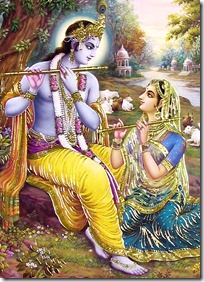 What does bhakti involve? As Parabrahman is transcendentally situated above all of His component energies, He has His own features. He is blissful, knowledgeable and eternal. He has sportive tendencies which require spiritual forms. The sportive exploits need participants as well. Obviously the Lord will choose only the most exalted devotees with which to enjoy. Hence our ideal position becomes quite clear. Follow the path of devotion and become one of these associates. Always in the company of the Lord, one can bask in the transcendental sweetness that emanates from the Supreme Person.
What does bhakti involve? As Parabrahman is transcendentally situated above all of His component energies, He has His own features. He is blissful, knowledgeable and eternal. He has sportive tendencies which require spiritual forms. The sportive exploits need participants as well. Obviously the Lord will choose only the most exalted devotees with which to enjoy. Hence our ideal position becomes quite clear. Follow the path of devotion and become one of these associates. Always in the company of the Lord, one can bask in the transcendental sweetness that emanates from the Supreme Person.
The absolute nature of the Supreme Lord provides that wonderful gift of association even to those who lack God’s personal presence. In bhakti, just thinking of God - His sweet smiling face, the sounds of His flute, the beauty of His figure - is as good as being in front of Him. God plays a flute? In His original form the Lord is described as being all-attractive; hence He is addressed as Krishna. Not to be confused with a sectarian figure or local folk hero, Krishna is the same God that everyone either worships or forgets. It is not that there is one God for the Hindus and another God for another group. Not everyone may know what He looks like or that He is Parabrahman, but this doesn’t mean that there are multiple personalities.
Krishna is so kind that He even expands into many non-different forms, such as Lord Vishnu
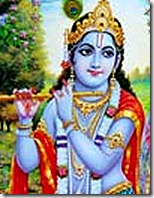 Shri Krishna is the positive form, for He has a transcendental body. He possesses mutually contradictory attributes, something unfathomable to the human mind. If these facts are accepted with a little faith in the beginning, they will be realized with full confidence eventually from within. The prescriptions provided by the Krishna devotee are validated by the resultant effects. Negation of bhakti activities is always harmful, as it leaves the Brahman realized soul stuck in a world of nothingness. Though such a world is free of misery, it is also free of bliss, which is what the soul craves. Accepting the positive form of Krishna’s beautiful face and the sounds of His names is so potent that it can automatically take care of the renunciation aspect. One who follows bhakti-yoga thinks of Krishna and His pleasure all the time. Thus what time is there left for indulgence in negative behavior, in forming material attachments? Through His association Krishna proves that He is above good and bad, that He can provide transcendental happiness that never has to vanish.
Shri Krishna is the positive form, for He has a transcendental body. He possesses mutually contradictory attributes, something unfathomable to the human mind. If these facts are accepted with a little faith in the beginning, they will be realized with full confidence eventually from within. The prescriptions provided by the Krishna devotee are validated by the resultant effects. Negation of bhakti activities is always harmful, as it leaves the Brahman realized soul stuck in a world of nothingness. Though such a world is free of misery, it is also free of bliss, which is what the soul craves. Accepting the positive form of Krishna’s beautiful face and the sounds of His names is so potent that it can automatically take care of the renunciation aspect. One who follows bhakti-yoga thinks of Krishna and His pleasure all the time. Thus what time is there left for indulgence in negative behavior, in forming material attachments? Through His association Krishna proves that He is above good and bad, that He can provide transcendental happiness that never has to vanish.
In Closing:
Who am I, what am I supposed to be?
With my eyes my temporary form all I can see.
Identify as human being, how is that bad?
From this no prejudice can be had.
Vedas say that Brahman realization is higher,
That spirit is same from species human to lower.
From Brahman we know that body we are not,
An existence beyond duality we have got.
To stay realized, material attachment we negate,
At the same time influence of senses we try to abate.
Yet beyond Brahman knowledge there is more,
Sublime bliss we have got existence for.
Reservoir of sweetness, Krishna is Brahman’s source,
Connect with Him to let real love show its course.
Only through bhakti realize the positive form,
The soul’s constitutional position it does inform.
 “In that city lives the leader of all men, Maharaja Janaka. He has every good quality, and during that time there was no other king like him.” (Janaki Mangala, Svayamvara Ki Taiyari, 6)
“In that city lives the leader of all men, Maharaja Janaka. He has every good quality, and during that time there was no other king like him.” (Janaki Mangala, Svayamvara Ki Taiyari, 6)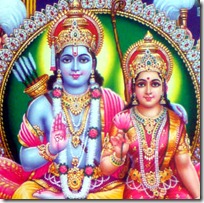 Why such attention given to a wedding? Beautiful people get married all the time, so why was this event such a big deal? When married under sacred Vedic principles, the wife becomes the goddess of fortune to the husband, giving him the support he needs to carry out his religious duties. Ironically enough, the lady getting married at this self-choice ceremony would one day be described as a sadharma-charini by her husband. One who follows the principles of dharma is considered on the right path towards rekindling their constitutional position. The wife’s duty is to help the husband in that quest, for his success equates to hers as well. Therefore a good wife is a heavenly blessing, a person who reinforces dedication to dharma instead of breaking it.
Why such attention given to a wedding? Beautiful people get married all the time, so why was this event such a big deal? When married under sacred Vedic principles, the wife becomes the goddess of fortune to the husband, giving him the support he needs to carry out his religious duties. Ironically enough, the lady getting married at this self-choice ceremony would one day be described as a sadharma-charini by her husband. One who follows the principles of dharma is considered on the right path towards rekindling their constitutional position. The wife’s duty is to help the husband in that quest, for his success equates to hers as well. Therefore a good wife is a heavenly blessing, a person who reinforces dedication to dharma instead of breaking it.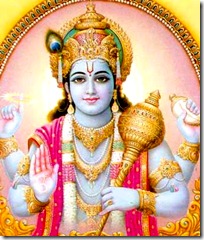 Man’s thinking is constrained by the concepts of time and space. We have no idea what eternal, orsanatana, means. Just try to sit down and contemplate what having no beginning and no end actually entails. Moreover, try to picture what it’s like to keep travelling in space and never reach an end. These are brain teasers that cannot be solved. Well aware of this limitation, the sacred texts that emanate from the original person, who is sanatana both in the duration of His existence and the scope and breadth of His pervasiveness, provide as much detail as man can handle. Since we are fallible human beings that have a source, the name Narayana automatically becomes one way to address God.
Man’s thinking is constrained by the concepts of time and space. We have no idea what eternal, orsanatana, means. Just try to sit down and contemplate what having no beginning and no end actually entails. Moreover, try to picture what it’s like to keep travelling in space and never reach an end. These are brain teasers that cannot be solved. Well aware of this limitation, the sacred texts that emanate from the original person, who is sanatana both in the duration of His existence and the scope and breadth of His pervasiveness, provide as much detail as man can handle. Since we are fallible human beings that have a source, the name Narayana automatically becomes one way to address God.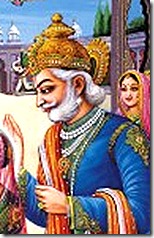 From the above referenced verse, we see that not only was Janaka the holder of every good quality, but there was actually no other king like him during his time. For starters, he had Sita as a daughter. The goddess of fortune chose him as a father during her time on earth. Obviously he must have been someone special. Janaka was also deferent to dharma, so much so that no one could find a flaw in him.
From the above referenced verse, we see that not only was Janaka the holder of every good quality, but there was actually no other king like him during his time. For starters, he had Sita as a daughter. The goddess of fortune chose him as a father during her time on earth. Obviously he must have been someone special. Janaka was also deferent to dharma, so much so that no one could find a flaw in him. Janaka was also famous for his mastery over mystic yoga. He had so much transcended the effects of the senses that he was known as Videha, or one who is without a body. The body is our vehicle for action, and as is true of any vehicle, the body carries some limitations. An automobile must be carefully constructed and then regularly maintained to operate properly. The car cannot just drive forever either; it needs to be filled up with gasoline every now and then. Similarly, the human body needs food, rest, clothing and shelter. With these needs come other influences that aren’t so kind. The tendencies towards
Janaka was also famous for his mastery over mystic yoga. He had so much transcended the effects of the senses that he was known as Videha, or one who is without a body. The body is our vehicle for action, and as is true of any vehicle, the body carries some limitations. An automobile must be carefully constructed and then regularly maintained to operate properly. The car cannot just drive forever either; it needs to be filled up with gasoline every now and then. Similarly, the human body needs food, rest, clothing and shelter. With these needs come other influences that aren’t so kind. The tendencies towards